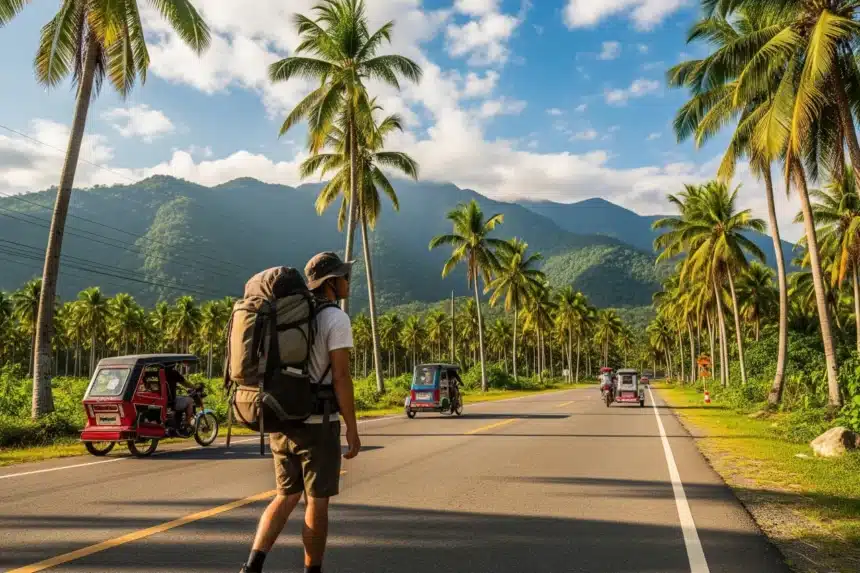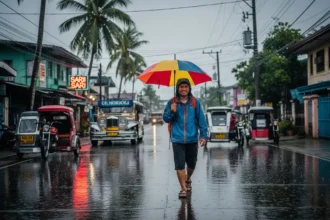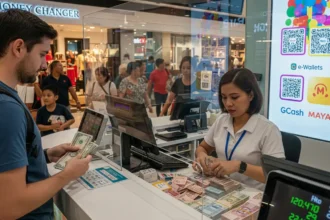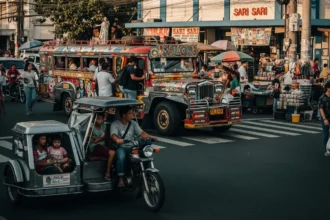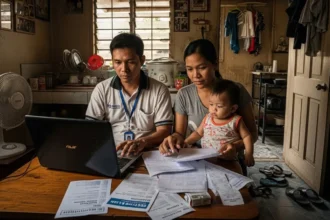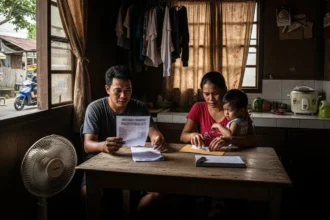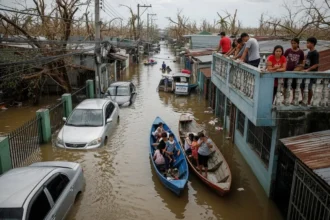Backpacking the Philippines is a rite of passage for both locals and foreigners who crave authentic travel experiences. Unlike package tours, backpacking allows you to explore the islands on your own terms – hopping on jeepneys, riding bangkas to hidden beaches, and sharing meals with strangers who might just become lifelong friends. The Philippines, with its 7,000+ islands, is tailor-made for this style of adventure.
For first-timers, however, it can be intimidating. The logistics of island-hopping, unpredictable weather, and the mix of rural and urban settings require flexibility and preparation. But those who embrace the spontaneity often say it’s the best trip of their lives. Imagine waking up in a ₱400 hostel by the beach in Siargao, riding a rented motorbike through coconut fields, and capping the night with a ₱50 bottle of Red Horse with new friends. That’s backpacking life – messy, unpredictable, but unforgettable.
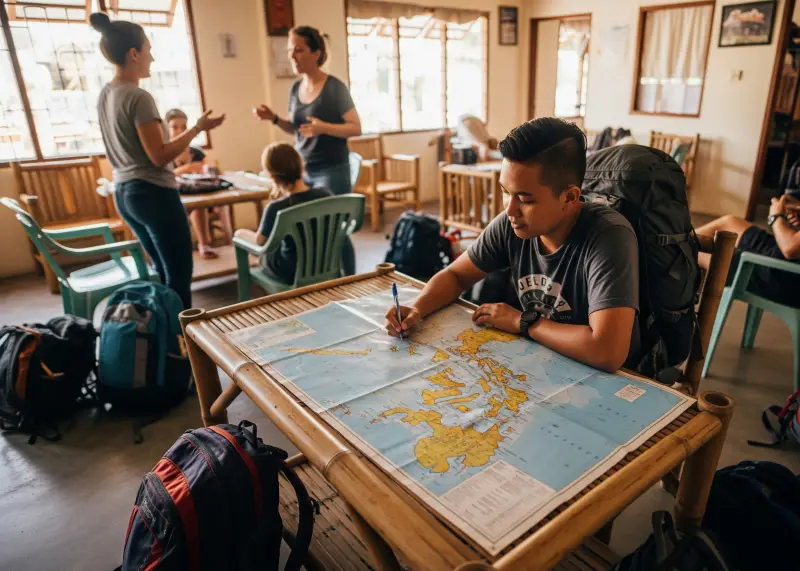
🛫 Planning Your Route
The Philippines isn’t like Thailand or Vietnam, where you can take long buses between destinations. Here, the geography requires combining flights, ferries, and land transport. Planning your route properly can save time, money, and headaches.
- Start in Manila or Cebu – both are major international gateways.
- Choose a region to focus on: Luzon (mountains, culture), Visayas (beaches, festivals), or Mindanao (adventure, but research safety first).
- Limit yourself to 2–3 major stops for a 2-week trip; too much hopping wastes time.
- Use budget airlines like Cebu Pacific or AirAsia but book early for promos.
- Factor in ferry schedules, which can be irregular.
Common Itinerary Ideas
- Classic Route: Manila → Banaue Rice Terraces → Palawan → Cebu → Boracay.
- Adventure Route: Cebu → Siquijor → Dumaguete → Siargao.
- Cultural Route: Iloilo → Bacolod → Cebu → Bohol.
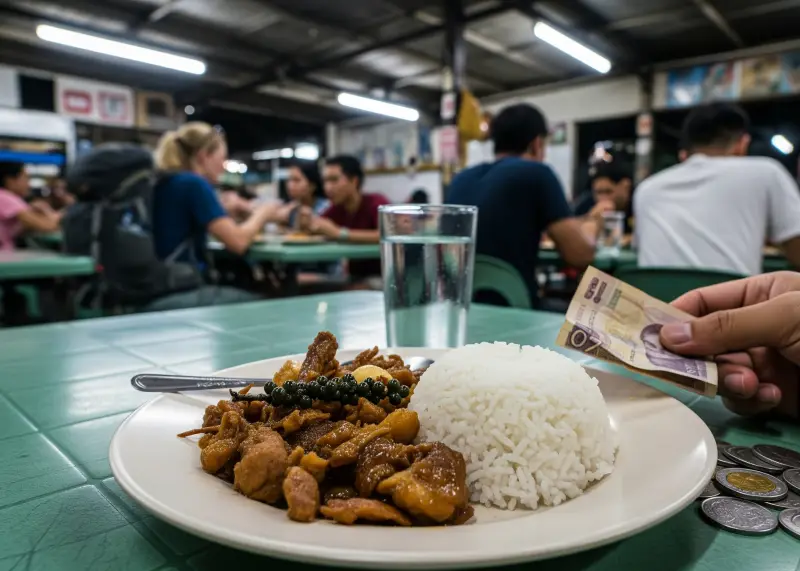
💰 Budgeting Like a Backpacker
Backpacking in the Philippines can be surprisingly affordable, but it depends on your choices. Prices vary widely between tourist hotspots and off-the-beaten-path towns.
- Hostels/Dorms: ₱400–₱800/night.
- Local Meals: ₱70–₱150 per karinderya plate.
- Inter-island Flights: ₱1,000–₱3,000 if booked in advance.
- Motorbike Rental: ₱350–₱500 per day.
- Island Tours: ₱1,000–₱2,000 including lunch.
| Expense Type | Low Budget (₱/day) | Mid Budget (₱/day) |
|---|---|---|
| Accommodation | 400–800 | 1,500–3,000 |
| Food | 200–400 | 700–1,500 |
| Transport | 300–500 | 800–1,500 |
| Tours/Activities | 500–1,000 | 1,500–3,000 |
Tip: Withdraw cash before heading to remote islands – many don’t have ATMs, and card payments are rare.
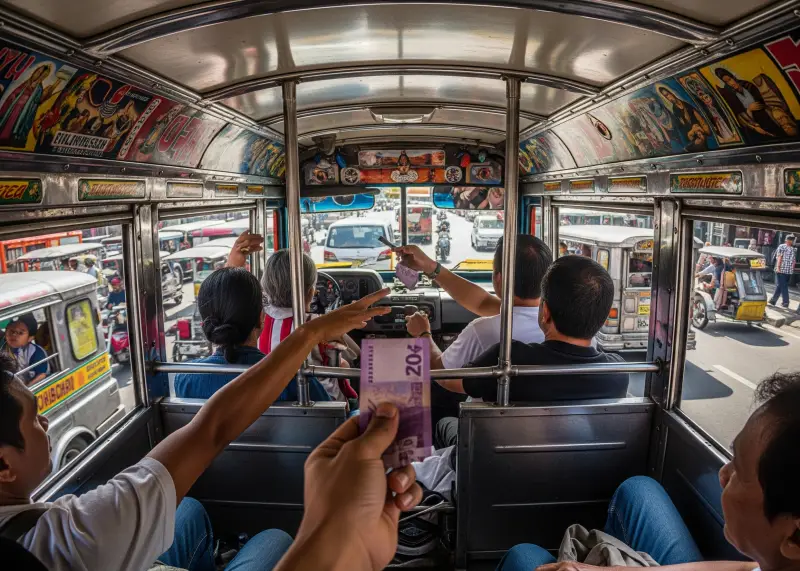
🚌 Getting Around Like a Local
One of the most rewarding aspects of backpacking through the Philippines is immersing yourself in the rhythm of daily life, and nothing gets you closer to that than using local transportation. It’s an adventure in itself. Don’t expect five-star luxury or rigid timetables, but do expect a journey filled with authenticity, resourcefulness, and plenty of character.
Jeepneys: The Kings of the Road
The jeepney is the undisputed cultural symbol of the Philippines. These flamboyantly decorated, open-air vehicles are the cheapest and most common way to travel short to medium distances within cities and towns. Riding one is a quintessential Filipino experience.
- How it works: Routes are painted on the side of the vehicle. You hail one from the side of the road, hop in the back, and find a seat on one of the two benches facing each other. To pay, you pass your fare to the person next to you, saying “Bayad po” (Payment, please), and it will be passed along a chain of passengers until it reaches the driver. Fares typically range from ₱15 to ₱20 for a standard ride. When you want to get off, you shout “Para po!” (Stop, please!).
Tricycles: The Local Taxi
For shorter trips within a town, navigating narrow side streets, or getting to your hostel from the bus terminal, the tricycle is your go-to. These are motorcycles with a sidecar attached, and they function as the local taxis in most provincial areas.
- How it works: You can hail them from the street or find them waiting at designated terminals. Crucial tip: Always ask for the rate before you get on. While there are often standard fares for locals, tourists can sometimes be quoted a higher “special trip” price. Negotiating politely beforehand ensures a fair price and a smooth ride.
Motorbikes: The Ultimate Backpacker’s Choice
For true freedom and exploration, nothing beats a motorbike. It’s the ultimate choice for backpackers wanting to get off the beaten path and discover hidden waterfalls, remote beaches, and scenic viewpoints on their own schedule.
- How it works: In popular tourist islands like Siargao, Bohol, or Siquijor, you can easily rent a scooter for a daily rate. For non-riders, the habal-habal (motorcycle taxi) is a popular option, where a local driver will take you to your destination, often navigating rough, unpaved roads that larger vehicles can’t access.
Ferries: The Lifeline Between Islands
As an archipelago of over 7,000 islands, ferry travel is an essential and unavoidable part of any Philippine adventure. The experience can vary wildly, from modern, air-conditioned fast craft that take a few hours to large, multi-story roro (roll-on/roll-off) ships for overnight journeys.
- How it works: Major ports connect the main islands, but be prepared for a fluid schedule. Delays are common due to weather or mechanical issues, so it’s wise not to plan tight connections. Embrace the journey itself; it’s a fantastic way to see the coastline and interact with locals.
Car Rentals: For Groups and Families
While rarely the most budget-friendly option for a solo backpacker, renting a car or van can be economical for a group. It offers the comfort and flexibility to explore a larger region at your own pace. However, be prepared for local driving conditions, which can be chaotic in cities and challenging in rural areas with unpaved roads.
A Final Note on the Journey
The experience of local transport is often as memorable as the destination itself. A backpacker once perfectly described his 8-hour ferry ride to Palawan:
“There was karaoke blasting, kids running around, vendors selling instant noodles and boiled eggs, and families sharing their meals on the floor. It felt less like a trip and more like being welcomed into a giant, moving Filipino family gathering.”
This is the essence of traveling like a local in the Philippines. It’s about embracing the organized chaos, sharing a smile with the person squeezed in next to you, and understanding that the journey is a vibrant, living part of the adventure.
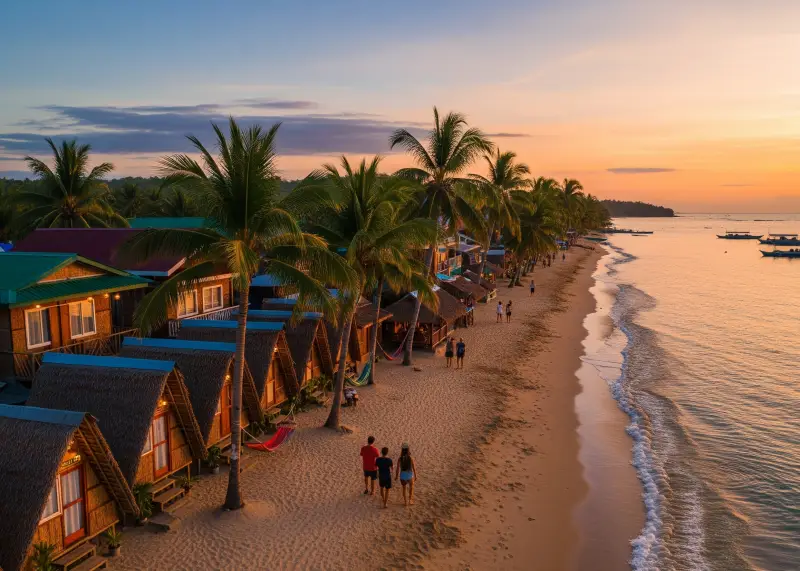
🛏️ Where to Stay
Backpacker-friendly accommodations in the Philippines have grown massively in the past decade. From rustic nipa huts by the beach to modern hostels with co-working spaces and Wi-Fi, there’s something for every style of traveler. Most backpackers prefer places with shared lounges or common areas, because this is where friendships are made over beers, guitars, or spontaneous island-hopping plans.
- Siargao: The island is backpacker central, especially in General Luna, where surf hostels and budget bungalows line the main road. Some hostels even offer free surfboard rentals or yoga classes. Don’t expect luxury, but do expect hammocks, communal dinners, and lots of barefoot, sandy travelers swapping surf stories.
- El Nido & Coron (Palawan): Both towns are known for island-hopping, and you’ll find affordable guesthouses, dorms, and inns tucked into narrow streets close to the beach. In El Nido, many hostels organize tours together, so even solo travelers quickly find groups to join. Coron, being smaller, has more laid-back guesthouses where the vibe is family-run and friendly.
- Cebu City: This is a transit hub for many travelers heading to southern islands. It’s not as beachy, but boutique hostels and budget hotels offer a comfortable stopover, with aircon dorms, cafés, and even work-friendly lounges for digital nomads. Mango Avenue is the nightlife spot, but if you want quieter nights, look near IT Park.
- Boracay: Despite its “party island” reputation, Boracay has backpacker inns too – especially near Station 3, where accommodations are cheaper, and the crowd is more relaxed. Think simple fan rooms, dorms, and bamboo huts just a few steps from the sand. The bonus? Sunsets here are the same as the ones seen from pricey resorts.
- Bohol: In Panglao, many family-run guesthouses cater to backpackers. You’ll find affordable stays with home-cooked meals, plus owners often treat guests like extended family. Outside Alona Beach, you can score cheaper and quieter options while still being a short ride from the action.
💡 Backpacker Tip: Always check if the hostel has a common kitchen – not just to save money, but to share meals with other travelers. Many lifelong friendships in the Philippines start over shared adobo cooked in a hostel kitchen.

🍲 Food on a Budget
The Philippines may not be as internationally hyped as Thai or Vietnamese food, but for backpackers, eating local is part of the adventure. Meals are not only cheap, but they come with a story – sometimes even with generosity you won’t forget.
- Karinderyas (local eateries): For under ₱100, you can fill your plate with rice, adobo, fried fish, or giniling. The setup is “turo-turo” style (point to what you want), and you eat side by side with locals. It’s not fancy, but it’s hearty, filling, and very Filipino.
- Street food: Backpackers love testing their stomachs with staples like kwek-kwek (quail eggs deep-fried in orange batter), isaw (grilled chicken intestines), and turon (banana wrapped in lumpia wrapper with caramelized sugar). It’s the cheapest way to taste the Philippines – and the smoky street-side grills often double as hangout spots with locals.
- Night markets: Cities like Cebu, Davao, and Cagayan de Oro have buzzing night markets where you can sample everything from skewers and noodles to halo-halo desserts. It’s not just about food – it’s about the music, the chatter, and the chaos that makes you feel alive in a foreign city.
- Regional specialties: Always try what the city is proud of. Iloilo’s La Paz Batchoy is best eaten in the market where it was born. Bacolod’s Chicken Inasal tastes better when eaten kamayan (with your hands). In Mindanao, Kinilaw (raw fish in vinegar) is fresh, zesty, and unforgettable.
✨ Backpacker Story: One traveler in Iloilo recalled eating at a karinderya and being waved off when he tried to pay. “Traveler ka? Libre na ito. Para may kwento ka pag-uwi,” the owner told him. That’s the Filipino way – hospitality so genuine it sometimes comes free with your meal.
💡 Backpacker Tip: If you want to stretch your budget, follow students or construction workers during lunchtime – they know where the cheapest, tastiest meals are.
🔐 Staying Safe
While most of the Philippines is safe for travelers, first-timers should exercise caution. Petty theft and scams happen, but violent crime against foreigners is rare.
- Avoid flashing expensive gadgets.
- Check travel advisories, especially if planning to visit parts of Mindanao.
- Respect local customs – dress modestly in rural areas and religious sites.
- Use Grab (ride-hailing app) in big cities instead of hailing taxis.
- Always secure your belongings in hostels.
Frequently Asked Questions
Is backpacking in the Philippines safe?
Yes, but like anywhere, use common sense. Stick to well-traveled routes if you’re new, and avoid isolated areas at night.
How much money should I bring for 2 weeks?
A budget traveler can survive on ₱20,000–₱25,000 excluding flights. Mid-range travelers may need ₱40,000–₱50,000.
Do I need to book everything in advance?
Not necessarily. Hostels and tours can often be booked on arrival, though flights and ferries should be arranged ahead of time.
What’s the best backpacking route for beginners?
Cebu + Bohol + Palawan is a classic beginner-friendly route that balances beaches, culture, and activities.
Can I backpack solo in the Philippines?
Absolutely. Many locals are friendly and English is widely spoken. Solo backpackers often find it easy to make friends.
Do I need travel insurance?
Yes, highly recommended. It covers medical emergencies, lost luggage, and unexpected cancellations.
Is it easy to find Wi-Fi or mobile data?
Wi-Fi is hit-or-miss, but SIM cards from Globe or Smart with mobile data are cheap and reliable in most urban areas.
What’s one thing first-timers overlook?
The time it takes to travel between islands. Always give yourself buffer days in case of ferry delays or canceled flights.
🌏 Backpacking as a Gateway to Real Philippines
Backpacking the Philippines isn’t just about ticking beaches off a list. It’s about embracing unpredictability, connecting with locals, and learning to slow down in a country where “Filipino time” is part of the culture. First-timers often arrive expecting a vacation but leave with friendships, stories, and a deeper appreciation for the resilience and warmth of the Filipino spirit.
So pack light, stay curious, and keep an open heart. The Philippines won’t just show you its islands – it will show you its people. And that’s the kind of journey that lingers long after your backpack has been unpacked.
🎒 References
-
DreamBigTravelFar – Backpacking The Philippines in 2025 (Epic Travel Guide)
-
Lubd – Ultimate Packing List for Philippines Backpacking 2025
-
JourneyEra – Philippines Backpacking Guide: Everything You Need
-
NomadicMatt – How to Visit the Philippines on a Budget in 2025
-
StokedToTravel – Complete Philippines Travel Guide: Budget & Tips
-
BucketListly – Backpacking the Philippines: Perfect 3-Week Route



